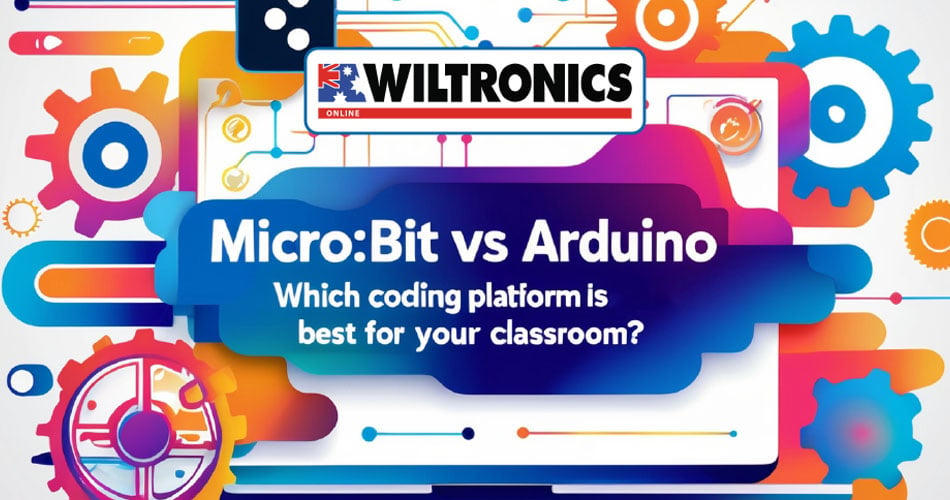Micro:bit vs Arduino – Which Coding Platform Is Best for Your Classroom?
May 8, 2025

Micro:bit vs Arduino – Which Coding Platform Is Best for Your Classroom?
A side-by-side comparison to help educators choose the right tech for their students.
With digital literacy and coding now core components of the Australian Curriculum, many schools are investing in programmable devices to teach students real-world tech skills. Two of the most popular platforms used in classrooms are the BBC Micro:bit and Arduino-compatible kits.
But which is better for your students? This guide compares Micro:bit and Arduino in key categories—age suitability, complexity, classroom application, and curriculum alignment—so you can confidently choose the right tool for your STEM program.
🧠 Why Use Microcontrollers in the Classroom?
Microcontrollers help students:
-
✅ Understand inputs, outputs, sensors, and logic
-
✅ Learn real-world programming skills (MakeCode, Python, C++)
-
✅ Build creative digital systems and prototypes
-
✅ Meet curriculum goals in Digital Technologies, Science, and Design & Technologies
🔍 Side-by-Side Comparison
| Feature | Micro:bit | Arduino-Compatible Kits |
|---|---|---|
| Best for | Years 5–8 (Primary & Lower Secondary) | Years 7–10 (Middle & Upper Secondary) |
| Programming options | MakeCode (block coding), Python | C/C++, Arduino IDE, some block-based options |
| Hardware | Built-in sensors, LED matrix, Bluetooth | Modular sensors, breadboard components |
| Complexity | Beginner-friendly | Intermediate to advanced |
| Power requirements | USB or battery | USB-powered (some kits battery-compatible) |
| Lesson structure | Simple projects: games, sensors, interactions | Full circuit projects, logic, real-world systems |
| Curriculum alignment | ACTDIP020–ACTDIP030 | ACTDIP031, ACTDEP049–ACTDEP051, ACSSU097 |
| Support at Wiltronics | Micro:bit Kits & Accessories | Arduino-Compatible Kits (e.g. ARD2) |
💡 When to Use Micro:bit
Choose Micro:bit if you’re introducing students to:
-
✅ Block-based programming (via MakeCode)
-
✅ Quick win electronics projects (e.g. step counter, flashing messages)
-
✅ Integrated sensors (light, motion, compass, buttons)
-
✅ STEM Clubs or lower secondary coding electives
Bonus: No breadboarding or external wiring required!
🔗 Shop Micro:bit Kits at Wiltronics
🔧 When to Use Arduino-Compatible Kits
Choose Arduino if your goal is to:
-
✅ Teach engineering-level coding logic and hardware control
-
✅ Build more complex circuits with inputs and outputs
-
✅ Explore sensor integration and physical prototyping
-
✅ Challenge senior students with open-ended design projects
🔗 Explore the ARD2 Arduino-Compatible Expanded Kit
🛠 Classroom Implementation Tips
-
📚 Start with Micro:bit in Years 5–7 to build logic and confidence
-
🔁 Progress to Arduino in Years 8–10 for deeper hardware/software integration
-
👥 Use both platforms in project-based learning and STEM clubs
-
🔁 Pair with real-world themes (e.g. sustainability, automation, smart cities)
🎓 Curriculum Integration
These platforms help meet:
-
Digital Technologies (ACTDIP020–ACTDIP031) – Data representation, digital systems, coding
-
Design & Technologies (ACTDEP024–ACTDEP051) – Planning, testing, evaluating solutions
-
Science (ACSSU097) – Electrical energy and systems
🛒 Why Wiltronics?
-
🇦🇺 Australian-owned and education focused since 1974
-
📦 Bulk pricing and class packs available
-
💬 Educator support for planning and product selection
-
🚚 Fast Australia-wide delivery
🚀 Empower Your Students to Code, Build & Think Creatively
Whether you start with Micro:bit or dive into Arduino, Wiltronics has the tools to help your students succeed with hands-on, future-ready learning.
👉 Explore Coding Kits for Schools
🎯 Long-tail keywords: micro:bit vs arduino in schools, best coding kits for classrooms, microcontroller kits for education, beginner electronics for STEM, australian curriculum coding kits
Micro:bit vs Arduino – Which Coding Platform Is Best for Your Classroom?
© Electrotech Brands Pty Ltd 2025


Write a Comment
You must be logged in to post a comment.